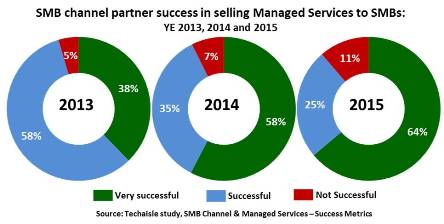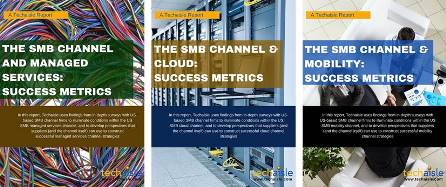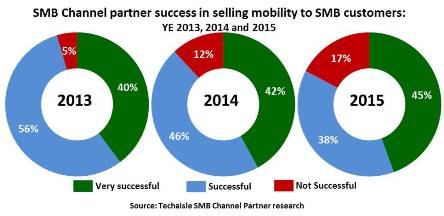Techaisle forecasts that US SMB IT spend growth rate could very well remain flat at US$188 billion in 2016 as compared to 2015. However, the US midmarket spending growth will likely increase by 6% whereas the small business spending will fall by 2 percent in 2016 from 2015. In early 2015, Techaisle had forecast US SMB IT spending to be US$180B by end of 2015 – based on most recent Techaisle SMB surveys the actual spending for 2015 came in at US$188B. Techaisle survey data shows some very interesting patterns for planned SMB 2016 IT budgets across different employee size businesses. Small businesses show progressive fall in IT budgets until they reach a certain size whereas midmarket businesses show budget increases until they reach a certain size.
Techaisle Blog
For all the talk of a world predicated on software-defined resources, there is still need for capable, reliable, scalable physical infrastructure to support these software layers and the features and applications that sit atop them. The rise in virtualization has been driving an accompanying demand for converged infrastructure: products that combine processing, storage and networking into a robust and scalable unit that can support and respond to the options inherent in virtualization.
While the migration from separate server, storage and networking products to converged infrastructure is still in its early stages, the Techaisle SMB & midmarket converged infrastructure survey and corresponding Techaisle SMB & midmarket virtualization adoption trends survey shows that it is beginning to gain traction, especially within more sophisticated accounts. Data shows that 10% of small businesses and 27% of midmarket businesses (weighted data) are planning to adopt converged infrastructure. Current midmarket adoption rates for converged infrastructure are below findings for VDI but differences readily become apparent when analyzing the data from the lens of Techaisle’s segmentation by IT sophistication. Converged infrastructure adoption rises steadily with increased buyer sophistication in both the small and midmarket segments. As the market matures, we expect to see accelerated adoption of converged infrastructure across the SMB market.
What is driving converged infrastructure adoption?
While there are technical advantages that make converged infrastructure products more effective virtualization hosts than traditional servers, Techaisle’s research shows that SMB buyers adopt converged infrastructure for one or more of five primary reasons:
- to benefit from converged infrastructure’s integrated design and efficiency,
- to tap into its ability to enable centralization/management of resources,
- to capitalize on performance/time-to-benefit advantages,
- to improve IT agility and its ability to meet business needs, and
- in response to core requirements for cost savings and improved security.
Drilling down into the data Techaisle finds that core requirements inform many converged infrastructure strategies, and the benefits and efficiency of integrated solutions are also frequently cited as a driver of converged infrastructure adoption.
Where is the SMB managed services channel today, as we enter 2016? Since 2013, managed services has taken deep root within the channel, and at the same time, some of the firms that were only casually involved with managed services have pulled back in order to focus in other areas. In the report, The SMB Channel & Managed Services: Success Metrics, Techaisle uses findings from 808 in-depth surveys with US-based channel firms to illuminate conditions within the US SMB managed services channel, and to develop perspectives that suppliers (and the channel itself) can use to construct successful managed services channel strategies. The survey identified a set of issues that is highly correlated with very successful managed services channel businesses, another that can be used to identify partners that are likely to be unsuccessful in managed services, and a third which lacks predictive value.
Results from three annual Techaisle channel surveys, shown in figure below, show that the trend towards specialization – in which channel members commit more strongly to managed services, or move away in order to focus on other areas – is well underway. 64 percent of the channel is ‘very successful’ in selling managed services, meaning that the population of very successful managed services channel members has increased by nearly 70 percent since 2013. A much smaller but growing proportion (currently 11 percent, more than double the 5 percent logged in 2013) acknowledges that it is not having success with managed services. MSPs and SPs report the highest level of success in selling managed services, while SIs, consultants and (especially) VARs are see less success.

A view of these findings organized by core business model provides additional insight into the partner communities where managed services are – and are not – gaining traction. As would be expected, managed service providers themselves are most likely to report success in managed services sales. Beyond this group, there are several interesting observations contained within the data:
- Nearly three-quarters of service providers state that they are “very successful” at selling managed services. This is an important issue within this community: SPs increasingly rely on managed services to differentiate their core hosting or connectivity services, which are (in many cases) relatively low-margin, and which offer limited prospects for future growth. Perhaps the most interesting finding for SPs is that 18 percent consider themselves to be unsuccessful in selling managed services. This group will be at risk as they compete with firms that augment core service presence with expanded, high-margin service portfolios that lock in an increased share of ‘customer wallet’.
- SIs are not especially aggressive in this space. At a high level, this data makes intuitive sense: SIs tend to have engagements that have a fixed duration and deliverable and managed services involve longer-term relationships tied to SLAs rather than functional specifications. However, it might be expected that SIs facing a shrinking product delivery market (due to increased use of cloud) might look to solidify customer relationships via managed services. The data shows that some SIs are following this path, they are either not committed to this strategy or are actively pursuing other options.
- Consultants and (especially) VARs are tepid in their pursuit of managed services business. Corresponding 2016 channel reports from Techaisle (see details below) show that VARs are finding great success in cloud, while consultants report that they are experiencing high levels of mobility sales success. Neither group seems particularly enthralled with managed services
It’s clear to all of us that today’s IT industry is comprised of many ‘moving pieces’. This is especially true in the SMB segment: with cloud, mobility and managed services, the buyer’s options have expanded; with the increased involvement of non-IT managers (in both ‘real’ and shadow IT), the buyer community has expanded; and with the channel’s struggle to understand and act on the new cloud-driven demands of a post-transactional IT market, the supply chain itself is undergoing tremendous change.
Techaisle is committed to working with the IT industry to ensure that these changes result in increased opportunity. Techaisle has recently completed two large-scale surveys – one of channel partners (VARs, SIs, MSPs, SPs and IT consultants) and another of SMBs (firms with 1-999 employees). We have also created a thought leadership piece, “Channel Imperatives for 2020: The Changing Channel for a Post-transactional IT market” which examines how 12 tenets of ‘conventional wisdom’ in the channel – mantras like the need to add value, or to increase service revenue, or to focus sales people on retiring quota, or to assemble and deliver best-of-breed solutions – are giving way to new management imperatives. We believe that this research is essential for suppliers looking to plot a channel-centric strategy for SMB market development by capitalizing on the insights contained in our analysis.
The series of three channel focused reports are The SMB Channel and Cloud: Success Metrics, The SMB Channel and Mobility: Success Metrics and The SMB Channel and Managed Services: Success Metrics. Each contains charts and analysis that can be used to identify high-value ‘very successful’ partners and avoid low-value ‘unsuccessful’ channel organizations. They are designed to connect with channel marketing, recruitment and management strategy.

Where is the SMB mobility channel today, as we enter 2016? Results from three Techaisle SMB channel surveys and compiled in report The Channel and Mobility: SMB Supply Options show that there has been substantial retreat from mobility as a core offering in the SMB and midmarket channel. In two years, the proportion of partners stating that they are unsuccessful at selling mobility has increased from 5% to 17%. There are likely two main reasons for this, a “push” and a “pull,” both related to the increased need for specialization in 1-2 of four main market areas (mobility, cloud, managed services, converged infrastructure/virtualization).
On the “push” side, Techaisle believes that many channel partners are struggling to find a profitable entry point to mobility. Supply of the devices themselves is not sufficient: buyers are deploying a wide range of client technology (PCs, smartphones, tablets) which has the effect of diffusing investments in PCs, diverting investment from the channel (since some technologies, especially smartphones, are generally acquired from telcos or other non-traditional-channel sources), and slowing PC refresh cycles (since client technology investment is now spread across 2-3 different devices). Additionally, the rise of BYOD is a double-edged sword: on the one hand, it increases the need for mobility management solutions (since these devices have greater need for security and related capabilities, such as audit/compliance monitoring), but on the other, authority for these devices doesn’t reside entirely within IT. And SMB channel partners are continuing to struggle on how best to offer mobility management solutions, mobility security solutions and bet on which vendor suppliers.

On the “pull” side, channel members who are being forced to abandon the ‘one stop solution shop’ positioning in favor of specialization in 1-2 of the core four areas need to decide if the uncertain journey into mobility has a greater overall benefit than focus on cloud, managed services and/or converged infrastructure/virtualization.















